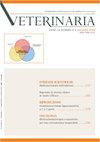EFFECT OF LOW DOSE GAMMA IRRADIATION ON NUMBER AND RATIO OF SOME PERIPHERAL BLOOD CELLS IN HATCHED CHICKS
Q4 Veterinary
引用次数: 0
Abstract
The presented research was carried out to investigate hematological response to low dose gamma radiation in chickens hatched from irradiated eggs. A total of 700 Ross-308 eggs were divided into the experimental group (N=360) and control group (N=340). The experimental group was irradiated one hour before incubation with a cobalt-60 (60Co) panoramic irradiator, and control group was sham irradiated. Blood samples for the red blood cell (RBC) and white blood cell (WBC) counts and differential blood counts were taken on the 1st, 3rd, 5th, 7th and 10th day of life. Blood cell counting was performed using the Natt and Herrick method. Leukocytes were differentiated using amicroscopic examination of stained blood smears and a heterophil:lymphocyte (H/L) ratio was calculated. Our results demonstrate a reduced RBC and WBC indicating negative effects of low-dose radiation on the blood cell counts in chicks during the first week after hatching. Significant decrease in the number of red blood cells on the 5th and 7th day and in the number of white blood cells on the1st and 3rd day, were obtained. Moreover, the number of lymphocytes in one-day-old chicken blood increased, while the number of heterophils decreased in response to radiation, suggesting better stress response in the exposed group. Further research is necessary to investigate the value of H/L ratio as a diagnostic indicator for radiation stress response and to evaluate cells and tissue reactions in specific time frames and across different taxonomic groups challenged by the low radiation dose. Extent of embryonic oxidative damage and recovery mechanisms should be also further investigated.低剂量辐照对雏鸡外周血细胞数量和比例的影响
本研究旨在探讨低剂量伽马辐射对受辐射鸡蛋孵化的鸡的血液学反应。选取700只Ross-308鸡蛋,分为试验组(N=360)和对照组(N=340)。试验组在孵育前1 h用钴-60 (60Co)全景照射器照射,对照组假照射。分别于出生后第1、3、5、7、10天采血测定红细胞(RBC)、白细胞(WBC)计数和差异血计数。采用Natt和Herrick法进行血细胞计数。利用染色血涂片的显微镜检查分化白细胞,并计算嗜白细胞:淋巴细胞(H/L)比。我们的研究结果表明,在孵化后的第一周内,低剂量辐射对小鸡血细胞计数有负面影响,RBC和WBC减少。第5、7天红细胞数量明显减少,第1、3天白细胞数量明显减少。此外,暴露组1日龄鸡血液中淋巴细胞数量增加,而嗜白细胞数量减少,提示暴露组应激反应较好。进一步研究H/L比值作为辐射应激反应的诊断指标的价值,评价低辐射剂量下细胞和组织在特定时间范围内和不同类群间的反应,是必要的。胚胎氧化损伤程度及恢复机制有待进一步研究。
本文章由计算机程序翻译,如有差异,请以英文原文为准。
求助全文
约1分钟内获得全文
求助全文
来源期刊

Veterinaria
农林科学-兽医学
CiteScore
0.10
自引率
0.00%
发文量
21
审稿时长
>12 weeks
期刊介绍:
VETERINARIA is the official scientific journal of the Italian Companion Animal Veterinary Association (SCIVAC) and is published bimonthly by Edizioni Veterinarie (E.V.). Its aim is to promote the spread and development of new ideas and techniques in the field of clinical and veterinary practices, with the ultimate goal of improving and promoting the continuing education of veterinary practicioners. VETERINARIA publishes literature reviews, original articles, diagnostic corners and clinical cases on different topics related to medicine and surgery of the dog, cat and of other companion animals, as well as short communications from congresses.
 求助内容:
求助内容: 应助结果提醒方式:
应助结果提醒方式:


